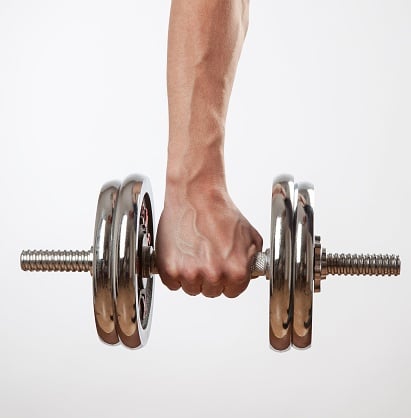 Grip strength is quite a conundrum in the fitness industry. It is so often called upon during training, yet grip-strength training itself can be overlooked.
Grip strength is quite a conundrum in the fitness industry. It is so often called upon during training, yet grip-strength training itself can be overlooked.
Many people don’t even think to train grip strength, or they don’t think that grip training will benefit them. Have you ever had trouble opening a jar or a can? Have you ever dropped a bag of groceries while trying to carry in every single bag from your car (like I do every Saturday)? Now do you think grip training might benefit you?
How Can a Better Grip Help You?
Any activity that involves holding something is going to require grip strength to some degree. Here are a few activities that may or may not come to mind when you think grip strength.
- Golfing: When playing golf, every shot you take requires you to hold a club. When holding the club, it pays to have a tight grip. Why? When you hit the ball, there is a transfer of energy from your hands to the club, and from the club to the ball. To get all of the energy from your hands to the club and the ball, you need to allow for as little movement of the club as possible when striking the ball. Grip strength is required to minimize the movement of the club upon striking the ball.
- Carrying a suitcase: Whenever you carry anything, you need grip strength. This usually isn’t a concern when the item you are carrying is light, such as a book or a cup. However, an item like a jam-packed suitcase can really test your grip when you are running through the airport to catch your plane. And if you work grip strength exercises into your workout routine, you can catch that plane and make it to family Christmas on time!
- Picking up a heavy object: This one seems like common sense, right? That’s because it is. When lifting a heavy object, such as a piece of furniture, grip strength is what keeps that object from crashing to the ground. You may have very strong legs, arms, and back, but if your grip is too weak to hold the object, you can’t move it!
So how can you train your grip to be stronger and have more endurance? There are many different ways, and here are a few (for more exercises, see this article):
- Using a thicker bar: A larger object is harder to hold onto than a smaller object. Therefore, a thicker barbell will be harder to hold onto than a thinner barbell. You can incorporate a thicker bar into your normal weightlifting routine by substituting it into every exercise you would normally do with a regular bar. Don’t have access to a thick bar? You can create a thicker bar. All you need is a couple of towels. Just wrap them around the bar to the thickness you desire, and you’re ready to go! (CAUTION: Be careful and use a spotter when weightlifting. A new technique means you will need to take time to get used to it.)
- Plate pinches and flips: If you’re lucky, your gym will have bumper weight plates (and yes, we have plenty here at the NIFS Fitness Center!). These work great for either plate pinches or flips. In a plate pinch, you pick up a bumper plate between your thumb and your other four fingers, and you either stand still to go for time, or you can walk with them and try to go for distance. In a plate flip, you grip the plate in the same way as you would for a pinch, and you do a half flip, catching the side of the plate that was just facing the ground. (Again, use caution when doing these exercises. These plates can be heavy, and if the exercise is done incorrectly, somebody could get hurt.)
- Dead hangs: For this, all you need is a pull-up bar. From a pull-up position, just hang freely from the bar for as long as you can. This will test your grip strength endurance, which is very functional for things like carries and holds.
***
This blog was written by Aaron Combs, NSCA CSCS and Health/Fitness Instructor. To find out more about the NIFS bloggers, click here.

 Whether you have particpated in our Powerlifting Competition or interested in joining, I’m going to give you a solid progression that will allow you to develop a strong power clean with proper technique. The following movements can be a starting point for beginners or experienced lifters looking to get a fresh perspective on their current programs.
Whether you have particpated in our Powerlifting Competition or interested in joining, I’m going to give you a solid progression that will allow you to develop a strong power clean with proper technique. The following movements can be a starting point for beginners or experienced lifters looking to get a fresh perspective on their current programs.

 There comes a time when a story of struggle, strife, and success must be shared to remind others that you are never alone in your battle, and that achievement and happiness are closer than you may think. Katie Feltman has such a story.
There comes a time when a story of struggle, strife, and success must be shared to remind others that you are never alone in your battle, and that achievement and happiness are closer than you may think. Katie Feltman has such a story.  You’d think with the scary words the doctor was saying I would have walked out of there that day and taken charge of things right then. But change isn’t like that—not for me, at least. I was frustrated with how I felt, and I know this will sound superficial but it is true: I hated how I looked, which I didn’t realize then but now know was key to my struggle. Self-hate = no self care, and that was how I was living my life. I was living life in a muted capacity, and I lacked the motivation to do something about it—any of it.
You’d think with the scary words the doctor was saying I would have walked out of there that day and taken charge of things right then. But change isn’t like that—not for me, at least. I was frustrated with how I felt, and I know this will sound superficial but it is true: I hated how I looked, which I didn’t realize then but now know was key to my struggle. Self-hate = no self care, and that was how I was living my life. I was living life in a muted capacity, and I lacked the motivation to do something about it—any of it.
 I recently received a lesson on the origin and true meaning of the word coach. A coach can be defined as something that takes you somewhere, such as a stage coach or coach seat on an airliner. But a COACH is someone who takes you where you want to go. One of the many powers of a coach is the ability to make memories and lessons that stick with you forever, that take you places every day. I have been coached for the majority of my life before ultimately becoming one because knowing the effect these special people had on me, I wanted to be that for someone else.
I recently received a lesson on the origin and true meaning of the word coach. A coach can be defined as something that takes you somewhere, such as a stage coach or coach seat on an airliner. But a COACH is someone who takes you where you want to go. One of the many powers of a coach is the ability to make memories and lessons that stick with you forever, that take you places every day. I have been coached for the majority of my life before ultimately becoming one because knowing the effect these special people had on me, I wanted to be that for someone else.
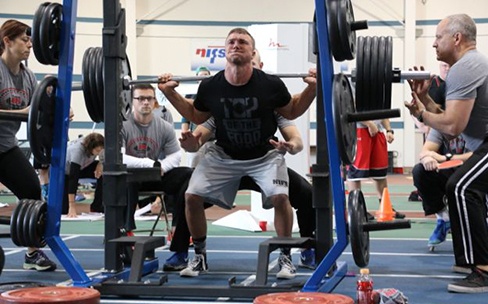 The fitness center floor was transformed into a makeshift coliseum so all could witness the battles that took place on those power racks and platforms. One could easily learn a great deal about the art of powerlifting, but I witnessed some rather big life lessons on display that were just as powerful as our two champions!
The fitness center floor was transformed into a makeshift coliseum so all could witness the battles that took place on those power racks and platforms. One could easily learn a great deal about the art of powerlifting, but I witnessed some rather big life lessons on display that were just as powerful as our two champions! 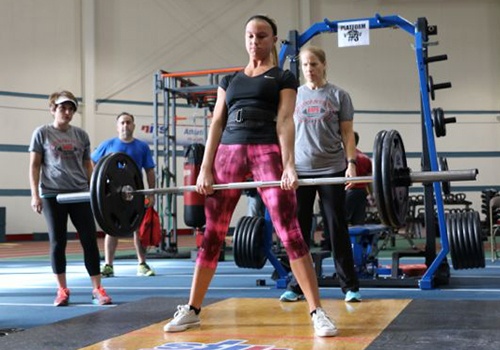
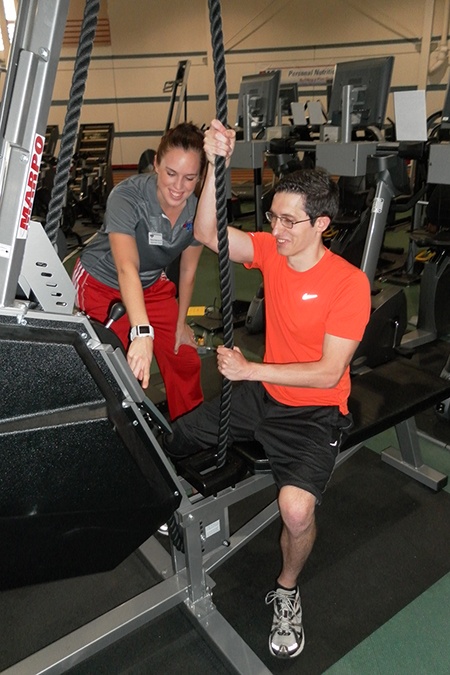 It’s that time again, everyone. Fall is upon us and the holidays are approaching… and what better way to start them all off than with NIFS’ 8th Annual
It’s that time again, everyone. Fall is upon us and the holidays are approaching… and what better way to start them all off than with NIFS’ 8th Annual 
 At times you may hear somebody at the gym or fitness center saying, “I don’t want to look like a bodybuilder,” or “I don’t want to be a powerlifter.” That’s great! That person knows their goals and also what they want to avoid. However, don’t let your specific goals cause you to have myth-generated fears of certain exercises.
At times you may hear somebody at the gym or fitness center saying, “I don’t want to look like a bodybuilder,” or “I don’t want to be a powerlifter.” That’s great! That person knows their goals and also what they want to avoid. However, don’t let your specific goals cause you to have myth-generated fears of certain exercises. 
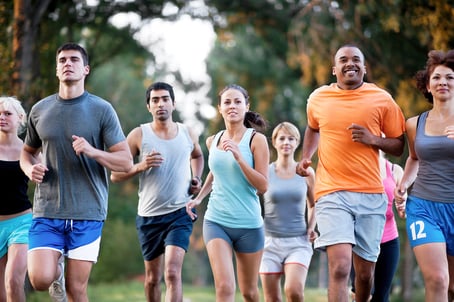 For years people have been running in marathons and half marathons, 10Ks and 5Ks. And most recently the wide world of racing has taken a turn for themed runs, which is quite exciting if you have ever been to one! But no matter how many years go by, two goals continue to come up: running farther, and running faster.
For years people have been running in marathons and half marathons, 10Ks and 5Ks. And most recently the wide world of racing has taken a turn for themed runs, which is quite exciting if you have ever been to one! But no matter how many years go by, two goals continue to come up: running farther, and running faster.
